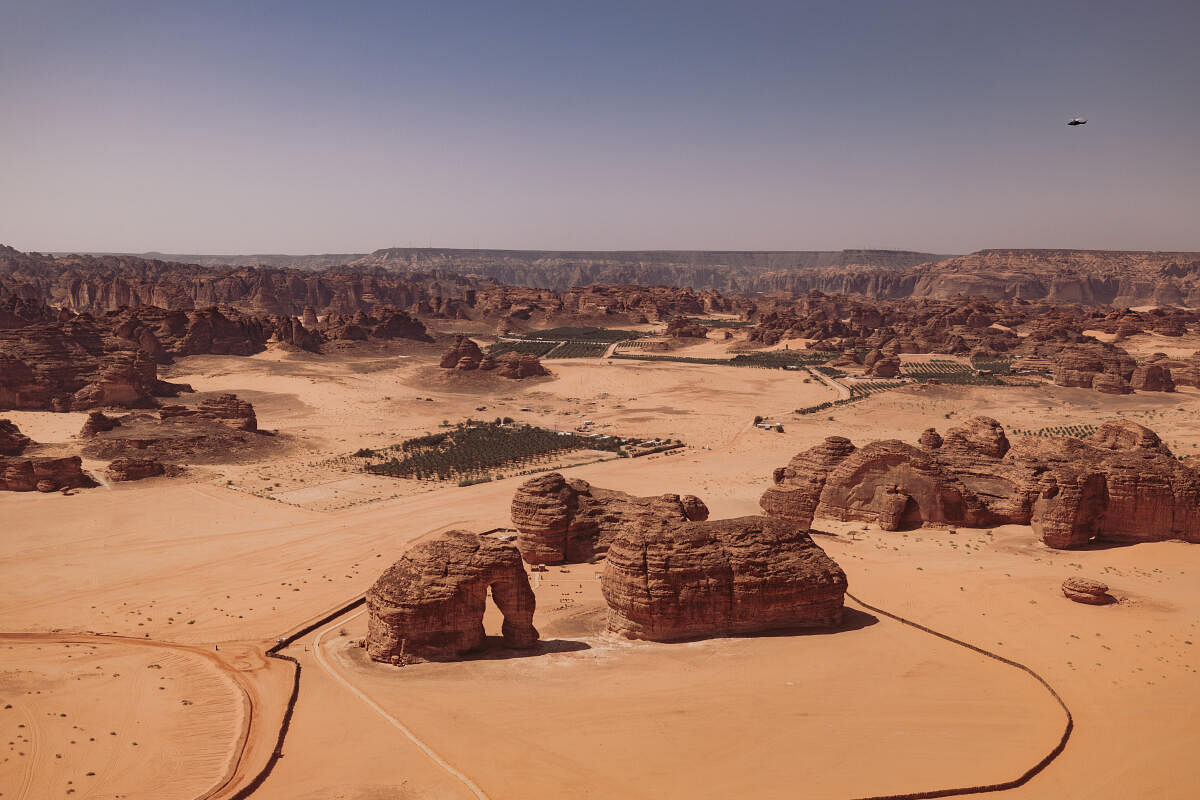

Wind gushing past my face, I lay on cushions and carpets embroidered with Persian motifs, strewn across the vast desert land. Our guide for the night points a laser skyward and narrates the story of two daughters protecting their father’s coffin. This is the story of the Big Dipper or ‘Alkaid’ in Arabic.
In ancient Arabic astronomy, the stars in the handle of the Big Dipper represented mourning and vengeful daughters and the bowl of the constellation represented the coffin of a father, who was killed by ‘Al Jadi’ (Polaris or North Star).
“For centuries, our ancestor’s ceiling was their guiding light. We have not only used the stars to find the way but they have also been a part of our stories and poetry,” the guide explains, as we immerse ourselves in the stargazing experience at Al Gharameel, surrounded by sandstones ravaged by time.
You’ll find these sandstones all across the city of AlUla, a hidden gem nestled in the heart of Saudi Arabia. It holds the remnants of the desert kingdom’s past and merges them seamlessly with modern luxuries. The city, blessed with fertile soils and an oasis of natural springs, was an essential stop along ancient intercontinental incense and spice-trading routes, and home to the Lihyan and Nabatean kingdoms.
While the skies and the picturesque sunrise and sunsets in AlUla are breathtaking, the star attraction of the new tourist hotspot is Hegra or Madain Saleh — a collection of 110 majestic tombs carved into the malleable sandstone rising from the desert. Declared a Unesco World Heritage Site in 2008, it happens to be one of the few remaining pieces of history belonging to the Nabataeans, the same kingdom known to have built Jordan’s prized possession, Petra.
The most iconic of the tombs is the Tomb of Lihyan, son of Kuza, it stands tall in all its glory. As you drive around Hegra with your ‘Ravi’, a local guide, one can’t help but admire the towering façades decorated with stairways to heaven and a few takeaways from Greek and Roman architecture. In the rocky outcrops across the city, you will also find yourself searching for stories and characters — I came across a face, a bowling pin and a falcon.
The dusty site looks even more mesmerising from 3,000 ft above the ground, as you float over it in a hot air balloon. The first rays of the Sun glisten over the tombs of Hegra, making them look mystical. Take your eyes away from the burial tombs, and you’ll find several colourful hot air balloons lazily drifting along the skies of AlUla. These are a part of the AlUla Skies Festival, the first edition of which was held in 2020. However, the hazy charm of the hot air balloons is in stark contrast to the thrill of being inside a helicopter as it zooms past the ancient city’s sand dunes. While the view from both is pretty similar, the thrill of the helicopter ride is unparalleled. It gives you a bird’s eye view of AlUla’s many breathtaking monuments — one of my personal favourites being the Maraya. Covered entirely in mirrors, Maraya is a concert hall and also houses an exclusive restaurant by Michelin Star chef Jason Atherton. Set in the middle of sand dunes, the idea is to ensure the building blends beautifully into its surroundings — reflecting the numerous glowing red canyons during the golden hour. It currently holds the title of the world’s largest mirrored building. The short helicopter ride also covers other attractions like the famous Elephant Rock and the city of Dadan, an erstwhile capital city. Another important part of AlUla is the Old Town. The neatly packed mud houses from the 12th century have been preserved and provide the perfect opportunity to deep-dive into the history of this land, which was untouched by tourists for years.
While the Kingdom of Saudi Arabia still struggles to figure out whether a dress with a slit or a tube top is acceptable apparel for women visiting the country, it is trying its best to compete with the tourism giant in its neighbourhood — and might I say, proving to be successful. With European and Middle Eastern tourists thronging to the currently viral travel destination on Instagram, the luxury resorts nestled among awe-inspiring sandstone formations remain booked throughout the year. Could this be a sign that Saudi is finally ready to share more such hidden wonders?
How to get to AlUla
The most convenient way to travel to AlUla from Karnataka is from Bengaluru via Dubai. During the summer, Flynas has five weekly flights from Dubai to AlUla and Flydubai has two weekly flights for the same route. The number of flights increases during the winter season. Throughout the year, the city hosts various events and festivals, such as the AlUla Skies Festival, Azimuth Festival, and Winter at Tantora. For details, visit experiencealula.com
(The writer was in AlUla on an invitation from the Royal Commission of AlUla, Saudi Arabia.)